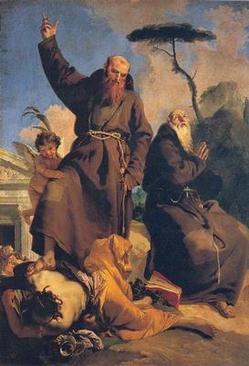Let us rejoice
and shout for joy, because the Lord of all things has favored this holy and
glorious virgin with his love.
God, our Father, You set Saint Colette as an
example and leader of evangelical perfection for many virgins. Grant that the
spirit of Saint Francis which she wisely taught and wondrously confirmed by her
holy example may ever abide in us.
Following the death of her parents, Colette,
with permission of the ecclesial authorities remained hidden from the world in
a room next a church where a window allowed her to adore the Blessed Sacrament.
Essentially she adopted an ancient form of religious life as an anchoress.
Colette embraced the rule of the Third Order of St. Francis, desiring to live
in perfect poverty, severe mortification, and constant prayer in order to become
like the Seraphic Father. The life she was graced to live had bountiful
consolations but she faced severe temptations and even corporal abuse from
Satan. Who, by the way, is clearly instrumental in trying to bring the Church to her knees.
Because her life as a Third Order Franciscan an interest developed to
know more about the life of Saint Clare and the early Poor Clare rule where the
ideal was to live in strict observance of the rule of Saint Clare. By this time,
history indicates that even the Poor Clares were a bit economical in living the
life Clare envisioned. Discerning that her call in life was not to take an
active role in re-forming the Poor Clare observance, Colette dismissed the
desires she had entertained. The problem was that these desires resurfaced
time-and-again to the extent that she discovered that God, not the devil, placed
the desire of reform in her heart. Rather boldly God got Colette’s attention by
striking her dumb and blind, until she finally resigned herself to the will of
God, like some notable biblical figures. Acknowledging the will of God, her
speech and her sight were restored.
You know the scenario: God never asks you
to do something without giving the grace to accomplish the task. A spiritual
father given to Colette to guide her spiritual life so that she could what the
Lord required. As preparation, Colette spent four years on before receiving the
blessing of the pope to establish one convent of Poor Clares. In time the
charism Colette proposed was corresponding to women’s desires that in her
lifetime Colette seventeen monasteries were founded under her inspiration. In the USA, the Colettine Poor Clares have a number of monasteries. One foundation that I would like to highlight is the Bethlehem Monastery of the Poor Clares, Barhamsville, VA.
Grace
upon grace was given to Colette for saving souls for Christ that in a vision
she saw souls falling into hell more swiftly than the snowflakes in a winter’s
storm. At once she knew her mission.
Saint Colettes’s devotion to the Passion
of Our Lord was evident which enabled her to make sacrifices to do what the
Lord wanted. With her friend, the Dominican, Saint Vincent Ferrer, she is
considered most responsible for the end of the Great Western Schism when the
Popes resided at Avignon, France between 1378 and 1417. Some Dominicans will likely dispute this claim, but as history is written on this period in Church history, Colette and Vincent seem to more key in papal correction than Saint Catherine of Siena is, but the latter’s influence is no doubt significant. The unity of the Church
was a stake when Colette and Vincent wrote to the Fathers in council at
Constance guiding them on how to deal with John XXIII, Benedict XIII, and
Gregory XII. They proposed the deposing of Benedict XIII in order for a new
election.






